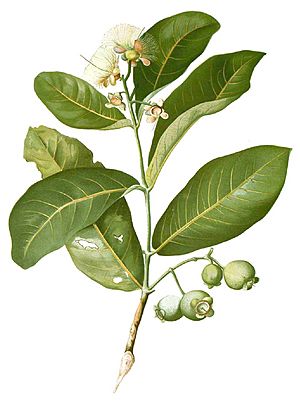Syzygium aqueum facts for kids
Quick facts for kids Syzygium aqueum |
|
|---|---|
 |
|
| Conservation status | |
|
Rare (NCA)
|
|
| Scientific classification | |
| Genus: |
Syzygium
|
| Species: |
aqueum
|
| Synonyms | |
|
|
Syzygium aqueum is a type of tree known by many names, including watery rose apple, water apple, and bell fruit. In some parts of India, people call it jambu. This tree is grown for its useful wood and its delicious fruit.
Contents
About the Water Apple Tree
The water apple tree is a kind of brush cherry tree. It is famous for its unique fruit. The fruit is shaped like a bell and has a waxy, shiny skin. It can be whitish-pink, yellowish-pink, or red. When you bite into it, it's crisp and full of water.
Where Water Apples Grow
This tree originally comes from tropical parts of Asia and Queensland, Australia. It loves places with lots of rain. Water apple trees can grow in tropical areas up to 1,600 meters (about 5,250 feet) above sea level. In the Philippines, this fruit is called tambis. People sometimes confuse it with another similar fruit called macopa (Syzygium samarangense).
What Water Apples Are Used For
The wood from the water apple tree is very strong. People use it to make different tools. The bark of the tree is sometimes used in herbal medicine for its special properties.
- Gardens and Parks: You can often see these trees planted in orchards, gardens, and parks. They are grown as ornamental plants because they look beautiful.
- Edible Leaves: The leaves of the water apple tree can also be eaten. Sometimes, people use them to wrap food.
The Delicious Fruit
The fruit of the water apple has a very mild and slightly sweet taste. Many people say it tastes a bit like an apple. Its texture is crisp and watery, similar to the inside of a watermelon.
- Popular in Asia: Water apples are a common sight at fruit stands in Southeast Asia. They are usually inexpensive when they are in season.
- Easy to Store: One great thing about this fruit is that it doesn't get bruised easily. You can even keep it fresh in a home refrigerator for several months.


